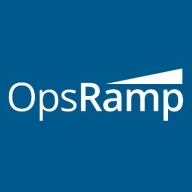

Splunk Observability Cloud and OpsRamp compete in the field of IT operations management solutions. Splunk appears to have the upper hand with its comprehensive monitoring capabilities and customization options, while OpsRamp stands out for its robust predictive analysis and ITSM integration.
Features: Splunk Observability Cloud offers robust data handling and user adaptability, providing comprehensive log analysis, custom dashboards, and efficient monitoring across diverse environments. Its application performance monitoring and integration with DevOps tools are valuable. OpsRamp excels in alert generation, offers seamless integration with ITSM tools, and provides personalized dashboards that cater to specific needs. Its predictive analysis and event correlation further enhance its cloud monitoring and infrastructure management capabilities.
Room for Improvement: Splunk faces challenges with data integration and cost, along with concerns regarding scalability and third-party integration. Users report that OpsRamp could improve in process automation and dashboard reporting, with a need for better alert management and performance indicators. Enhancements in ITSM maturity and patch management processes are also suggested.
Ease of Deployment and Customer Service: Splunk Observability Cloud supports on-premises, public, and hybrid cloud deployments, offering flexibility. However, its customer service receives mixed reviews, with room for improvement in service speed and expertise. OpsRamp focuses on public cloud deployments, providing effective customer service, especially for bundled solutions, with consistent support for cloud environments.
Pricing and ROI: Splunk Observability Cloud is noted for its high cost, although it provides ROI through improved monitoring and reduced downtime. Its pricing model is considered expensive compared to competitors. OpsRamp offers a more cost-effective model, aligning with resource usage and providing full platform access. This makes OpsRamp a more economically attractive option for cost-conscious buyers.
Problem resolution typically takes between two and five days, which isn't very helpful.
If any issues arise, we can raise a vendor case, and resolutions are provided in a timely and accurate manner.
They did not have a clear answer.
We've used the solution across more than 250 people, including engineers.
I would rate its scalability an eight out of ten.
We rarely have problems accessing the dashboard or the page.
I would rate its stability a nine out of ten.
It would be beneficial if server details could be retrieved directly in synthetic monitoring.
Customers sometimes need to create specific dashboards, particularly for applicative metrics such as Java and process terms.
There is room for improvement in the alerting system, which is complicated and has less documentation available.
Splunk Observability Cloud is expensive.
It appears to be expensive compared to competitors.
It offers unified visibility for logs, metrics, and traces.
Saving time with automation can save us weeks. It's improving our resilience.
Unlike other APMs, Splunk's service map is quite effective.


OpsRamp is a leading cloud-based digital IT operations management platform. The solution allows your organization to leverage hybrid observability, process automation, and machine learning to modernize IT operations. OpsRamp can handle the speed, scope, and scale of modern IT and can help you drive productivity and business value. In addition, it can help your business manage, monitor, and consolidate your point tools and applications.
OpsRamp Features
OpsRamp has many valuable key features. Some of the most useful ones include:
OpsRamp Benefits
There are many benefits to implementing OpsRamp. Some of the biggest advantages the solution offers include:
Splunk Observability Cloud combines log search, data integration, and dashboards for seamless monitoring, enhancing infrastructure visibility and security. Its cloud integration and scalability support diverse environments, improving operational efficiency.
Splunk Observability Cloud offers comprehensive monitoring tools with user-friendly interfaces, enabling end-to-end infrastructure visibility. Its real-time alerting and predictive capabilities enhance security monitoring, while centralized dashboards provide cross-platform visibility. Users benefit from fast data integration and extensive insights into application performance. Despite its advantages, improvements could be made in integration with other tools, data reliability, scalability, and cost management. Users face challenges in configuration complexity and require better automation and endpoint protection features. Enhancing AI integration, alerts, and adaptation for high-throughput services could further improve usability.
What are the key features of Splunk Observability Cloud?In industries like finance and healthcare, Splunk Observability Cloud is implemented for application performance monitoring and infrastructure metrics. Its ability to track incidents and analyze machine data benefits network infrastructure, while distributed tracing and log analysis aid in tackling security threats. Organizations often integrate it for compliance and auditing purposes, enhancing visibility into network traffic and optimizing performance.
We monitor all IT Infrastructure Monitoring reviews to prevent fraudulent reviews and keep review quality high. We do not post reviews by company employees or direct competitors. We validate each review for authenticity via cross-reference with LinkedIn, and personal follow-up with the reviewer when necessary.